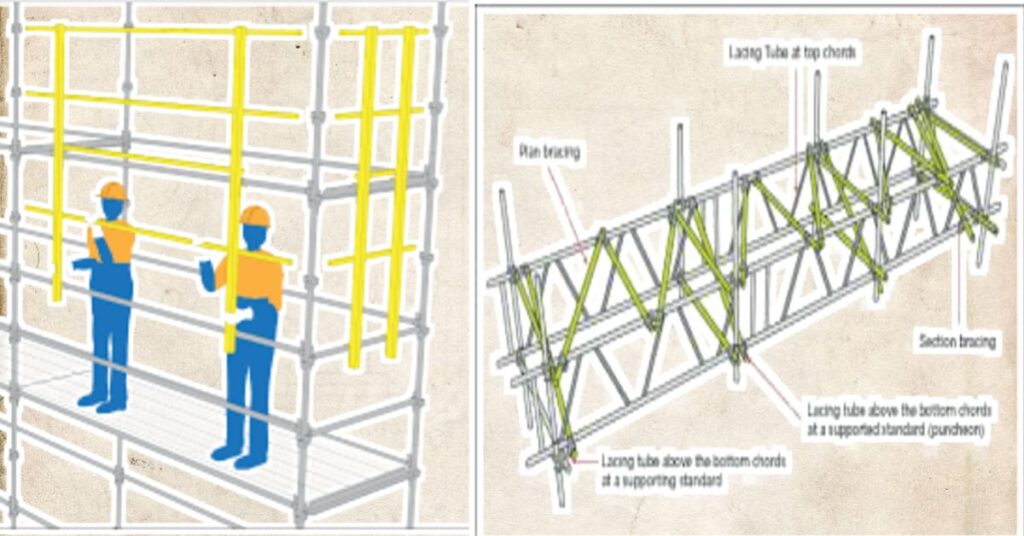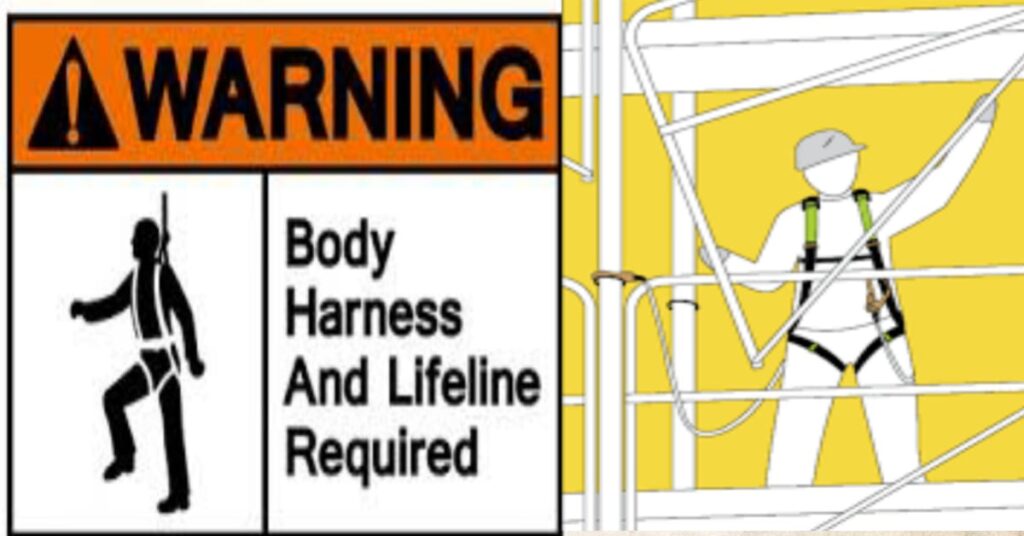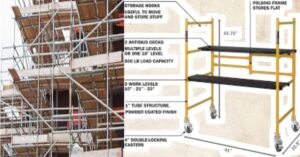Anchorage Safe points of anchorage for lifelines or lanyards, which are part of a personal
fall arrest system, including fixed, substantial structural members. Anchorage points shall
be fixed and able to support a load of at least 2,300 kilograms (5,000 pounds).
Base Plate A steel plate providing a flat bearing surface with a spigot or screw jack for
distributing the load from posts (standards). It has an integral spigot and fixing holes for
use with sills.
Bearer (Transom) A horizontal transverse scaffold member, that may support platform
units, and which is supported by at least two runners (ledgers) or connected directly to at
least two posts (standards).
Board Carrier (Middle Transom) a transverse, horizontal scaffold tube that the scaffold platform partially rests on. Board bearers are not positioned next to a transverse row of posts, or standards; instead, they are supported by runners, or ledgers.

Safety belt, or body belt A strap featuring mechanisms for fastening it around the waist and for securing it (with a lanyard) to an anchor or lifeline. utilized to provide workers with their location restricts the risk of falling (i.e., keeps the wearer away from a rooftop edge). Body belts are not allowed to incorporated into a system for personal fall arrest.
Box Fastener a set of tubes and couplers assembled to form a frame around a building’s column or other structural element, serving as the scaffold tie tube anchor point. Also called a box tie for a column.
Hold on tight a stiff scaffold tubing connection that maintains one scaffold element in a fixed place in relation to another element to provide stiffness to the scaffold.
Cross Supporting Additionally, two diagonal braces connected at the middle to form a “X” eferred to as cross braces or “X” bracing.
Brace Diagonally A scaffold tube positioned perpendicular to the vertical and horizontal scaffold members, and fastened to them such that the scaffold steadiness. longitudinal bracing (Facade or Sway) Installed in the scaffold’s larger dimension (length) are diagonal braces. Refer to Figures I
Arrange for Bracing Braces placed in a horizontal plane that are specifically utilized in tower and movable scaffolds.

Transverse Bracing (Ledger or Sectional) Installed in the plane of the scaffold’s shorter dimension (width) are diagonal braces. Refer to Figures II
Bracing using Dog Leg Zig-Zag End-to-end positioning of diagonal braces and that switch back and forth.
A pivoting wheel with a wheel lock that is fastened to a vertical piece of post (standard) of a movable scaffold to enable the scaffold to be manually moved.
Coupler (Clamp, Fitting) An element or apparatus for fastening scaffold tubes collectively.
Coupler types include:
Adaptable (Swivel) Coupler An apparatus that joins two tubes togetherat a non-90 degree angle Bearer (Putlog or Single) Coupler An apparatus for securing a carrier (transom) putlog) to a runner (ledger), or to join a guardrail-only tube to a post (conventional).

Verify (Safety) Coupler a Right-angle coupler installed to a loaded joint on an underhung scaffold to provide the coupler bearing the weight with additional security against slippage.
End-to-End (Sleeve) Coupler: An external device that joins two (2) scaffold tubes arranged end to end coaxially. The steel barrier is situated in the middle of the make sure every tube is inserted equally.
Girder Coupler a mechanism for joining a steel wide-flange beam (I-beam) with a scaffold tube. Girder couplers must only be used in sets of two, with one on each the inverse flange. Likewise known as a “SK” (Steel-Clamp).
(Double, 90-degree, load-bearing, or standard) Right-Angle Coupler A coupler that bears loads and is used to join two tubes at an angle. It is an essential part of the scaffold structure and needs to be resistant to both warping. Prefabricated Platform, Deck, or Scaffold Plank A scaffold platform unit outfitted with hooks at the end that attach to the scaffold bearer (transom).
Error load resistance, component part separation, buckling, breaking, or slipping. In the case of a carrier or other simply supported bending element, load refusal can be defined as the point at which a full depth plastic hinge forms at the midspan (plastic moment = yield). modulus of plastic section under stress periods).
Entire Body Restraint A set of adjustable straps that can be fastened around a person in a how the fall arrest forces are distributed across the shoulders, chest, thighs, and pelvis, includes connections to allow it to be connected to other parts of a personal fall arrest system.
Safety Measures A barrier that is built to keep workers from falling off an elevated work area and from objects falling onto workers below. It consists of top rails, mid rails, toe boards, and supporting uprights Comprising:
Top-rail The highest horizontal rail within a guardrail structure.
Mid rail A horizontal rail that is situated roughly at the middle of a the platform and the guardrail system. Pedalboard a guardrail fastened to a platform’s ends and sides to protect against the material, tools, and other items dropping.
Gentlemen In order to improve the scaffold’s lateral stability, tension members—also known as wire ropes—are positioned between the scaffold and the ground, a building, or another structure.
Hanger Tube Similar to and used for the same load-carrying function as posts (standards), with the exception that hanger tubes are loaded and hung from an already-existing structure under strain.
Warm Surface A structure’s or piece of equipment’s surface that is hotter than 70 degrees Celsius or 160 °F. Combined Pin (Growing Spigot) An expanding fitting used to link scaffold posts coaxially is inserted into the bore of a typical scaffold post. This tool manages compression but not tension while connecting posts (standards) in tube and coupler scaffolds vertically.
loads, strain. Stepladders An apparatus for ascending vertically between levels, comprising:
Ladder of Extension A foldable ladder that is self-supporting but may altered in length. It is divided into two pieces that are positioned to allow for length adaptation.
ladder that is straight A transportable ladder with a single part that ascertains its entire length. It is not self-supporting and cannot have its length changed.
Lanyard A full body harness wearer is secured to a lifeline or point of anchorage by a flexible line with a positive way to lock end connections closed (such as locking type snaphooks or carabineers with a self-closing, self-locking keeper).
Absorbing Shock Lanyard a specifically made lanyard with an integrated shock absorber that lengthens during a fall to provide energy dissipation so that fall The number of arresting officers is drastically decreased (by 65–80%) in comparison to a conventional rope lanyards or webbing. A lanyard that absorbs shock restricts the restricting the individual’s maximal arresting force to less than 8,000 Newtons (1,800 pounds).
Vital Sign A part made up of a flexible line that can be attached to an anchorage at one end to hang vertically (vertical lifeline) or to an anchorage at both ends to stretch horizontally (horizontal lifeline), and that can be used as a means of connecting other elements connecting the anchoring to a personal fall arrest system. Another name for lifelines is lines that are used as fright, drop, safety, rat, or static lines, etc.
Elevate the grouping of bearers (transoms) and runners (ledgers) creating a horizontal level of a scaffold. A building’s floor and an elevator are comparable. Base Elevation A elevator with the initial group of runners inside was constructed close to the ground. (transoms) and bearers (ledgers). Also referred to as “foot tie” and “foot lift,” Kicker Lift”
Head Room Lift the obvious separation between a platform and the lift’s tubular assembly above.
Lift Height: The vertical separation between two lifts, comparable to the storyline in a constructing.

Load Rating: Maximum designed loading and live load for scaffold design must comply with the subsequent classifications:
Light-duty: Scaffold built and designed to support workers’ weight alone; it does not store any materials beyond the weight of tools. Frequently used for painting, light cleaning, access, and inspection. uniformly dispersed maximum The load intended is 120 kg/m^2. 25 lb./ft2 (1.2 kN/m2).
Medium-duty: A scaffold built and designed to support workers, light tools, and supplies. If there is a chance that abrasive will accumulate on the platforms (because not every platform is regularly cleared of abrasive), the scaffolds used for abrasive blast cleaning, or “sandblasting,” will be categorized as medium-duty. The maximum designed load, spread uniformly, is 240 kg/m2 (2.4 kN/m2), or 50 lb./ft2.
Special-duty scaffold is defined as one that is specifically made and engineered to support maximum intended loads above 240 kg/m2 (2.4 kN/m2) (50 psf), such as scaffolding, machinery, or masonry work. Lower Level: Any area below the level that an individual is at and that he may fall to. Ground levels, floors, roofs, ramps, runways, excavations, pits, tanks, supplies, water, and equipment are a few examples of these spaces.
Also read more: Scaffolding Training
Maximum Desired Load The highest weight that can be applied to a scaffold or a scaffold component at any given moment from all people, tools, materials, transmitted loads, equipment, and other live loads (not including scaffold or plank self-weight). Point of Node The point where a standard post and a runner (ledger) or post and bearer (transom) intersect. Outsider Beam (Incomplete) a cantilevered structural component that holds up a scaffold with its point of connection facing away from the building’s or structure’s face.
Outsider The structural components of a supported scaffold that are utilized to widen the scaffold’s base to provide it more stability and support. System of Personal Fall Arrest a device that stops someone from falling. It includes a complete body harness, connectors, and a considerable anchorage. A lanyard, deceleration device, lifeline, or appropriate combinations of these may also be included (see CSM Chapter I, Section ).
A single timber board or manufactured piece (without end hooks) used as a platform’s flooring component is called a plank (also known as a scaffold board).
Platform One or more platform components combined with a guardrail system make up this elevated work space.
Unit of Platform a single wooden plank, a manufactured plank, a manufactured deck, or a manufactured platform. The vertical scaffold tube known as the post (standard) supports the weight of the scaffold.
Puncheon (False Upright): A vertical tube that is not supported by the ground or deck, but rather by another scaffold tube or beam at the bottom.
Raker a load-bearing, slanted tube that braces the scaffold off the ground. A scaffold tie tube anchor point is provided by a reveal tie assembly, which consists of a reveal tube, a reveal pin, and any necessary pads fastened between opposing faces of a wall opening.
Reveal Tie: An assembly consisting of a reveal tube, a reveal pin, and any necessary pads that are placed between opposing faces of a wall opening to serve as a scaffold tie tube anchor point.
SWL, or safe working load The maximum load that a scaffold component can withstand as defined by the manufacturer.
Framework A makeshift raised platform, either supported or underhung, and the ties that hold it up are utilized to support laborers, supplies, or both. Scaffold types include: Supported by Base Framework a scaffold where the standards (posts) are not overhung but rather supported at the base.
Scaffold for Birdcages a scaffold that has more than two lines of hanger tubes (if underhung) or posts (standards) spanning its breadth.
Scaffold Bracket (for Tank Builders) bracket straps that are welded to the tank wall to support the scaffold. The straps are attached onto upright brackets.
Tubular Frame Scaffold Fabricated a scaffold made up of one or more platforms supported by end frames, horizontal bearers, and intermediate members that have been manufactured.
Independent Run Scaffolding (Façade or Independent Tied) a scaffold with two lines of posts, or standards, one line supporting the platform(s)’ outside and one line supporting the platform(s)’ interior. The bearers, or transoms, are not included into the structure’s wall. For stability, it is typically attached to the building.
Transient Scaffold a stiff scaffold structure that is manually movable horizontally and is supported by casters.
System Framework a framework made up of braces that can be joined at preset levels, runners (ledgers), bearers (transoms), and posts (standards) with fixed connection sites.
Tower Guardrail A supported scaffold that forms a square or rectangular tower is made up of just four (4) poles, or standards, joined longitudinally by runners, or ledgers, and bearers, or transoms, at right angles to one another. A tower scaffold can be built using system scaffolding, fabricated tubular frames, or tubes and couplers.
Coupler and Tube Scaffold A steel tube scaffold with posts (standards), runners (ledgers), bearers (transoms), braces, and ties; a base to hold the posts; and specifically made scaffold couplers to join the different components.
Underhung Scaffold (Slung or Suspended) A scaffold with an immovable work platform that is suspended from an overhead structure directly above by fixed length wire ropes (cables) or permanently fastened by scaffold tubes and load-bearing couplers to an overhead structure directly above (not outrigger beams).
Measurements for Scaffolds the measurements of a scaffold. Bay the distance on a scaffold’s face between the centerlines of neighboring posts, or standards.
Bay Length is the longitudinal, horizontal distance measured between the centers of two nearby posts (standards). Altitude The height in meters between the base of the scaffold and the highest group of runners (ledgers) and bearers (transoms).
Length: The length of the scaffold is the horizontal distance between the extreme longitudinal posts (standards) along the runners (ledgers); it is also occasionally denoted by the number of bays. longitudinal the scaffold’s long direction, which is often parallel to its planks.
Crosswise the scaffold’s short direction, which is often perpendicular to the planks.
Width: The greatest horizontal transverse distance of a scaffold, measured from the center of the posts (standards) that are the furthest apart and at right angles to the runners (ledgers). Occasionally identified by the quantity of planks that can fit between the posts.
A screw jack is a load-bearing apparatus that is positioned at the scaffold’s base to account for variations in ground level.
Sole Board or Sole Plate Sill a wooden spreader that disperses weight from a base plate to the earth.
Particular Framework A scaffold that satisfies any of the following requirements, for which the scaffold plan must be reviewed by a structural engineer:
greater than 38 meters (125 feet), or a tube and coupler scaffold that is cantilevered over three meters (10 feet) in height, or more than thirty square meters (320 square feet) of total platform area, supported by or hung from an existing structure or building (e.g., roof, pipe rack, offshore platform), or supporting loads more than 240 kg/sq.m. (50 psf), such as masonry, piping, equipment, and new or existing structures, or loads other than workers and their materials,
supported by or suspended from wind girders, the roofs of floating roof tanks, or one or more outrigger beams.
spigot an internal fitting that is fastened or pinned to connect two standard posts coaxially. utilized in scaffolds for systems.
Spigot Pin: To keep the spigot from pulling out of the tube, a transverse bolt or pin is inserted through both the spigot and the conventional scaffold post. Also referred to as coupling pin, dowel pin, and tension pin.
bind scaffold parts, such as tie tubes fastened to the scaffold, that are erected to give a scaffold an anchor point to a building or other structure. used to give the scaffold lateral stability. Fastening Tube A conduit that links the scaffold to a tie anchor position (i.e., box tie, reveal tie, two-way tie).
Trapeze conduit A horizontal scaffold tube put at the bottom of the hanger tubes, about two feet below the runners (ledgers), with a length of 300 to 450 mm (1.5 to 2.0 ft.) It is employed in the construction, alteration, and breakdown of an underhung scaffold. In the event that the runner trips, it also acts as a backup support.
Two-Path Connection a scaffold assembly that passes through a hole in a wall or other solid structure to serve as the scaffold tie tubes’ anchor point. Likewise called a through tie.
Working Level: A raised area that holds tools, laborers, and/or supplies.
Overhead Work Areas: Essential Conditions
Fall Protection:
A) fall protection system must be in place to keep everyone safe from falls that could cause them to fall more than 1.8 meters (6 ft.) Guardrail and personal fall arrest systems are examples of fall protection devices. The use of guardrails or other fixed fall protection is advocated over personal fall arrest devices.
B) While building, modifying, or disassembling a scaffold, every scaffold craftsman is required to wear a full body harness with a shock-absorbing lanyard at all times. If it is feasible, any scaffold craftsman who is not protected by a guardrail system and has the potential to fall more than 1.8 meters (6 feet) must securely anchor his lanyard.
If securing the lanyard to a stronger anchorage—such as a lifeline—is not feasible, it must merely be fastened to the scaffold. Scaffold craftsmen can find comprehensive information about appropriate fall protection methods in NASC Guidance Note SG4:00.
Also read more scaffolding standard:
Guardrail Systems:
A) Any exposed sides and ends of elevated work locations (such as scaffold platforms and stair landings) where a person could fall 1.8 meters (6 feet) or more must have guardrail systems installed. These systems include top rails, mid rails, toe boards, and support uprights.
B) Top rails’ top edge heights cannot be lower than 0.95 meters (38 inches) or higher than 1.15 meters (45 inches) above a platform’s walking/working surface.
C) Mid rails must be positioned roughly midway between the top rail and the walking/working surface.
D) Affixed firmly to the interior of vertical uprights (posts) are top rails and mid rails. Guardrail-supporting vertical uprights must not be more than 2.7 meters (9 feet) apart.
E) Guardrail systems must be able to sustain, at any point on the top rail or comparable part, a force of at least 90 kg (200 lbs.) exerted in either a downward or horizontal direction without failing.
F) Before anyone other than scaffold artisans may use an elevated work location, guardrail systems must be installed.
G) All horizontal guardrail ends must not protrude past the end uprights unless doing so does not put workers at risk of projection.
H) Gaps or holes in elevated work areas must be filled securely with structurally substantial material or have a guardrail system built around them.
I) A guardrail system must be installed along the edge of an elevated work area (including scaffold platforms) or personal fall arrest equipment must be utilized if the horizontal distance between the edge and the wall or structure exceeds 360 mm (14 inches).
J) In areas designated for material lifting, if feasible, a guardrail system measuring no less than 1.2 meters (4 feet) in length must be installed on both sides of the entry point used for material lifting. When hoisting operations are not underway, the gap between the guardrail parts must be adequately closed with a chain or gate.
Personal Fall Arrest Systems:
A) Everybody on an elevated work area or platform must always utilize a personal fall arrest device in the event that a full guardrail system cannot be put in place. A complete body harness, lanyard, considerable anchorage(s), and potentially a lifeline are components of a personal fall arrest system.
B) Using safety or body belts as a component of a personal fall arrest system is strictly prohibited.
C) The user is required to examine every part of the personal fall arrest system he intends to use before each usage.
D) The manufacturer must grade and mark full body harnesses (including D-rings), lanyards (including snap hooks), lifelines, and other parts of personal fall arrest systems for a capacity of at least 2,300 kg (5,000 pounds).
E) Personal fall arrest systems must be fastened by lanyard to an overhead structural anchorage or a vertical or horizontal lifeline that can sustain up to 2,300 kg (5,000 pounds) when in use.
F) If at all possible, lanyards must be tied off to a lifeline or anchorage point high enough—preferably above shoulder height—to keep workers from falling more than six feet (1.8 meters) or hitting any lower level in the event of a fall.
G) The maximum length for lanyards is 1.8 meters (6 feet). It is permissible to connect two or more lanyards together (hook to eye) as long as the total distance that can be free fallen is limited to 1.8 meters (6 feet). But in these cases, self-retracting lanyards—also known as inertia reels—are the better option.
H) Locking type snap hooks or carabineers with self-closing, self-locking keeper shall be attached to the end of each lanyard to prevent rollout. D-rings and snap hooks shall be compatible to prevent rollout.
I) Lifelines must be independent, secured to a permanent safe point or points of anchorage that can support 2,300 kg (5,000 pounds), and shielded from abrasion and sharp objects. Structural members are acceptable safe points of anchorage; however, guardrails, standpipes, vents, other small-diameter piping systems, electrical conduit, outrigger beams, and counterweights are not.
J) Wire rope with a minimum diameter of 10 mm (3/8 inch) must be used to make both vertical and horizontal lifelines. A lifeline made of any other material, such as nylon, polypropylene, or manila rope, is not permitted.
K) Horizontal lifelines shall be installed at the highest feasible point, preferably above shoulder height. Horizontal lifelines shall be maintained with a sag at the center no greater than 300 mm (12 inches) for every 10 meters (33 feet) of lifeline length between attachment points.
L) Continuous monitoring of workers donning personal fall arrest systems is required by supervision in order to enable timely help in the event of a fall.
M) After stopping a fall, personal fall arrest system components may not be repurposed or used again if there is any indication of damage.
When equipment, tools, or materials are stacked higher than the top edge of the toe board and there is a risk that they could fall through guardrails and strike workers or equipment below, a protective screen made of at least No. 18 gauge wire and at most 13 mm (½-inch) mesh size needs to be firmly fastened to the top rail, mid rail, and toe board.
A) In addition to donning hardhats, workers can be further protected from falling objects by:
• blocking off the area below where objects may fall and preventing access to the area of danger; or
• erecting debris nets, catch platforms, or canopy structures large enough to capture falling objects.
B) A canopy structure, debris net, or catch platform must be sturdy enough to endure the impact pressures of potentially falling objects.
C) Unless a material is self-supporting and stable, it should not be stacked, piled, or grouped.

